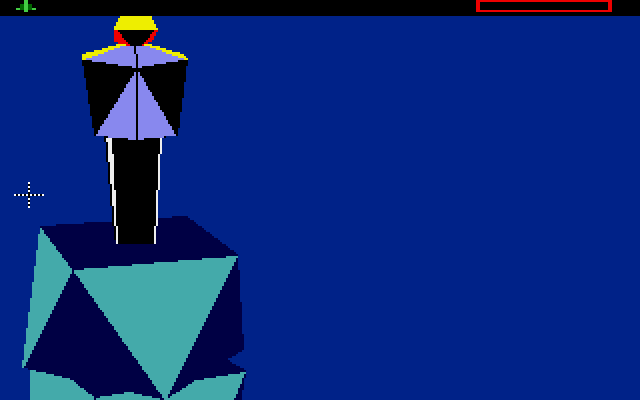softchassis (![[personal profile]](https://www.dreamwidth.org/img/silk/identity/user.png) softchassis) wrote in
softchassis) wrote in ![[community profile]](https://www.dreamwidth.org/img/silk/identity/community.png) rainbowgames2015-09-20 11:42 am
rainbowgames2015-09-20 11:42 am
Entry tags:
The Sentinel

Think back to when video games were primarily 2D and the platforms video games tended to be on had the tiniest fraction of the power they do today, all the while innovation being the name of the game. Video games were still fairly new, and ambition was high, ideas good and bad are being published and programmed all around. It's 1987, and computer users are still talking about the ambitious 1984 Elite, a game which seemed to, somehow and miraculously, cram all of outer space itself into their humble 8-bit computers. The polygons rendered in it were just wireframe, however. Were consumer computers able to render filled polygons?
It turns out, in a manner of speaking, they were. Thanks to the ingenious programming of Geoff Crammond,1987 saw the eccentric, first-person view, "consciousness transferring" puzzler known as The Sentinel.

The Sentinel is a "game of energy", as described by its manual, but today it'd be classified as a puzzle or strategy game. In The Sentinel, you are tasked with destroying the titular Sentinel of each map, which always resides at the map's highest point, before it destroys you. The sentinel lies dormant until it detects a disturbance--that'd be you--in which case it starts slowly rotating, scanning the map. If it notices something unnatural in the map, it breaks it down into energy and then uses that energy to plant trees. That includes you! If the sentinel sees you, it starts draining your energy away, provided it can see the tile you're standing on completely.

You can absorb energy as well, and that includes the sentinel's energy. However, you cannot move around the map freely; instead, you spend energy points, which you gain by absorbing trees from the landscape, to place a series of "synthoids" to which you "transfer", as well as "boulders" which you can stack on top of each other to gain height--which is vital, as you can only absorb something if you can see the entire base of the tile it is standing on. If you happen to find yourself stuck with nowhere to go, you can also hyperspace jump to a random point on the map, provided you have the energy to create a synthoid first.

Through this process of absorbing energy and transferring from synthoid to synthoid, you must eventually reach an equally high or higher place on the map so you can see the entire base on which the sentinel is standing, absorb it, and then place a synthoid where the sentinel used to be and "hyperspace jump" to the next area.

The sentinel doesn't work alone, either. If it can't see the tile you're on completely, but can see you, it'll turn a nearby tree into a "meanie". If the meanie is able to see the tile you're on, it'll make you hyperspace jump! In addition, some maps have "sentries", which act just like sentinels, except they can be anywhere.
Each object requires a certain amount of energy to place, as shown by a bar in the upper left. Trees and meanies are worth one point., boulders are two, synthoids and sentries are three, and sentinels are four. The amount of excess energy at the end of each level affects how many levels you'll ascend. It's very possible to go straight from level one to level nine if you get greedy with the energy!

Meanwhile, the upper right corner of the screen has an odd bar in it. If it's empty, you're safe. If it's filled with electricity, you're being absorbed!
All of this takes place in a 3D first-person perspective of whichever synthoid you are currently inhabiting. The ingenious part of this game's design lies there: since you can't freely move and can only 'move' by moving from synthoid to synthoid, the game only has to render one 360 degree panorama at a time, giving the illusion of existing in a 3D space, as demonstrated by the .gif below.

Isn't that clever? As you can see by the curved perspective, each rendered screen is one continuous image!
The concept is a bit hard to grasp at first, but once you understand it, you can see why The Sentinel a compelling game, even today. Its combination of puzzle solving, resource management, and a sprinkling of stealth makes it incredibly unique, and surprisingly fun. I've uploaded a video of the first level if you'd like to see just how to play the game.

As with most computer games in the 80s, The Sentinel was ported to basically every mass market computer platform available, starting out on the BBC Micro and finding its way onto the C64, Amstrad, Atari ST, Amiga (which is the version I played), MS-DOS and even the humble ZX Spectrum. It was met with high acclaim and went on to have many remakes by fans.
Curiously, in 1996, it got an official sequel named Sentinel Returns on the PC and PS1, with a bizarre gothic medical body horror theme and music by John Carpenter. Aside from the gloomy atmosphere, it plays exactly the same as the original, except hyperjumping to the next level does not require energy.

If you want to play something totally unique and fun, I definitely recommend The Sentinel. Which version you play is up to you, as they're all mostly the same (though the Amiga version has music), and there's tons of fan remakes which are easier to setup than an emulator.